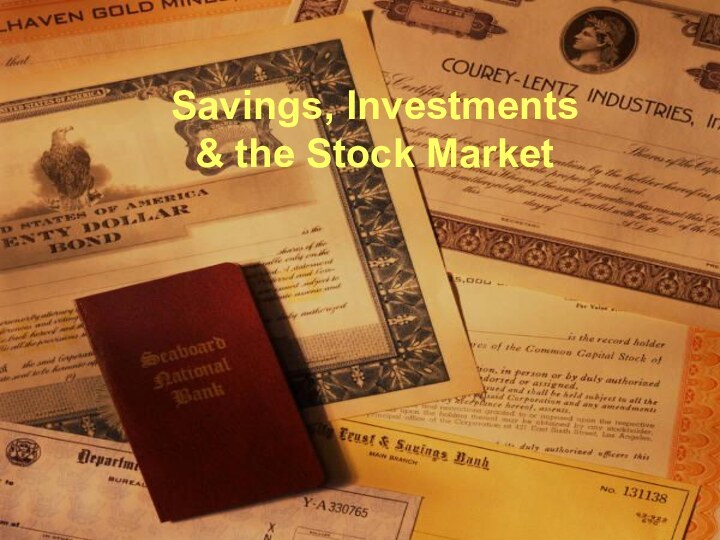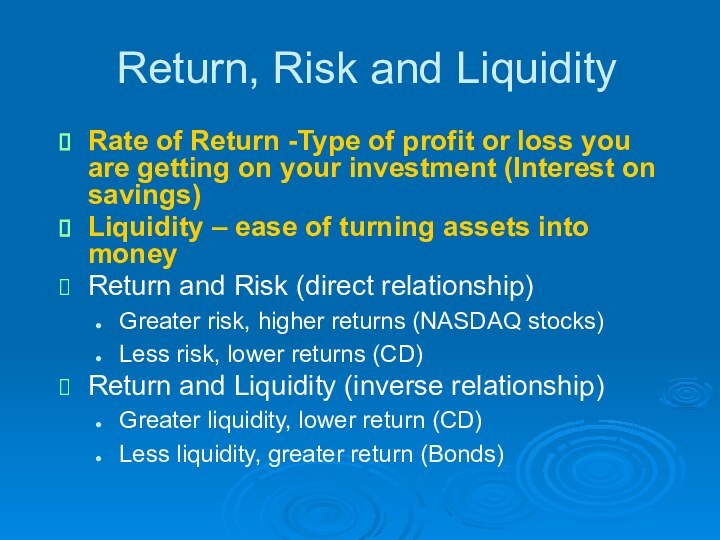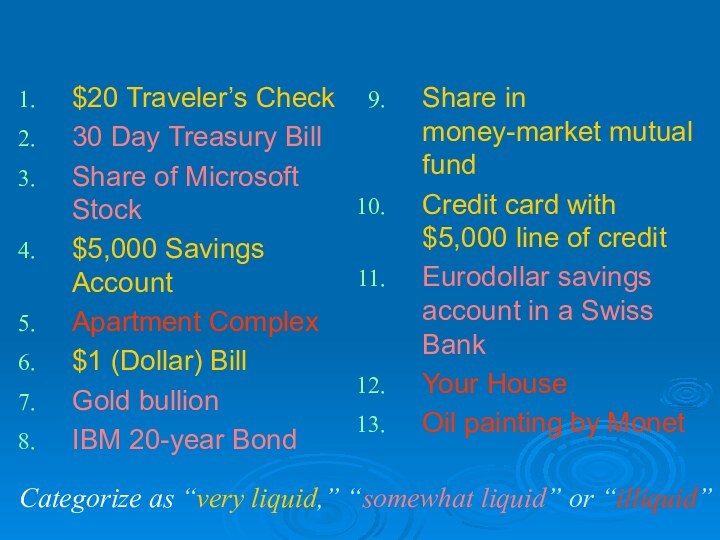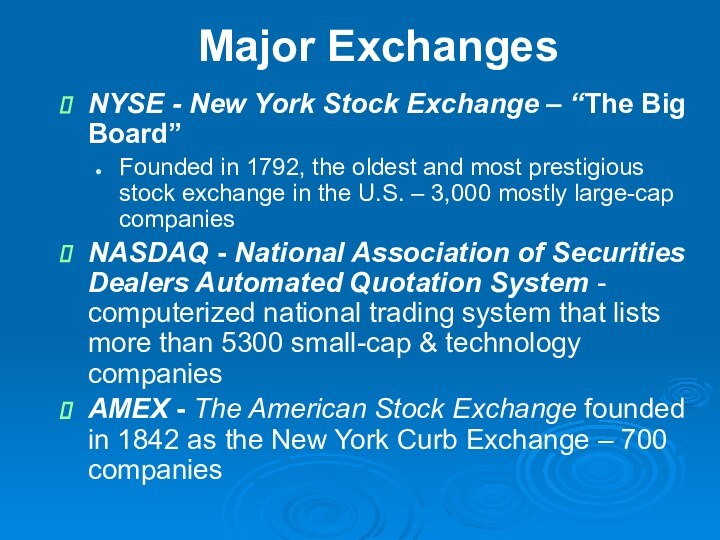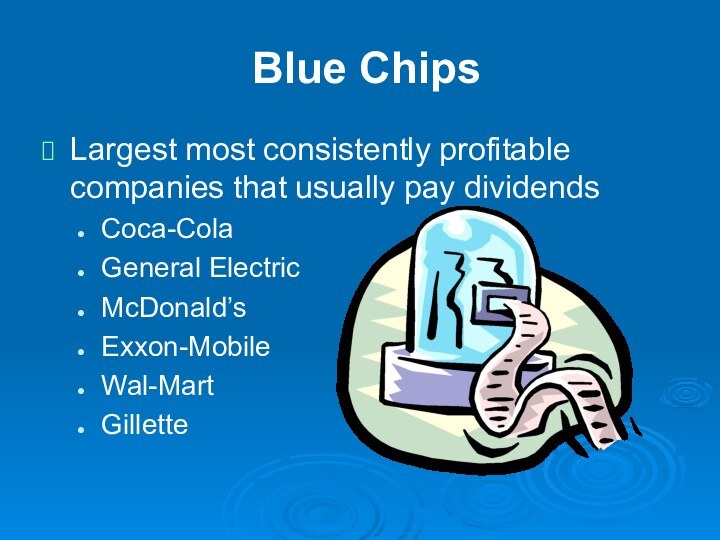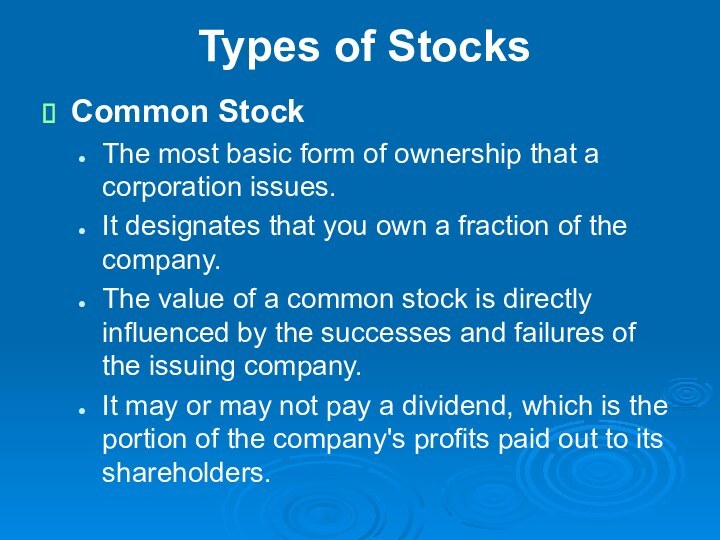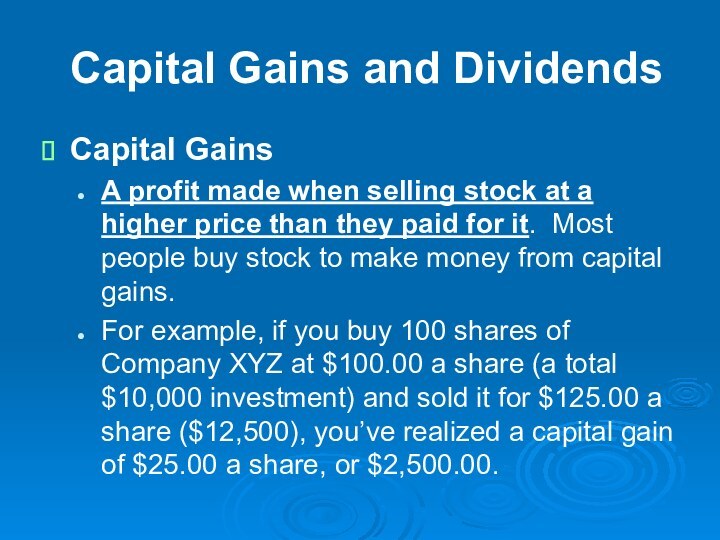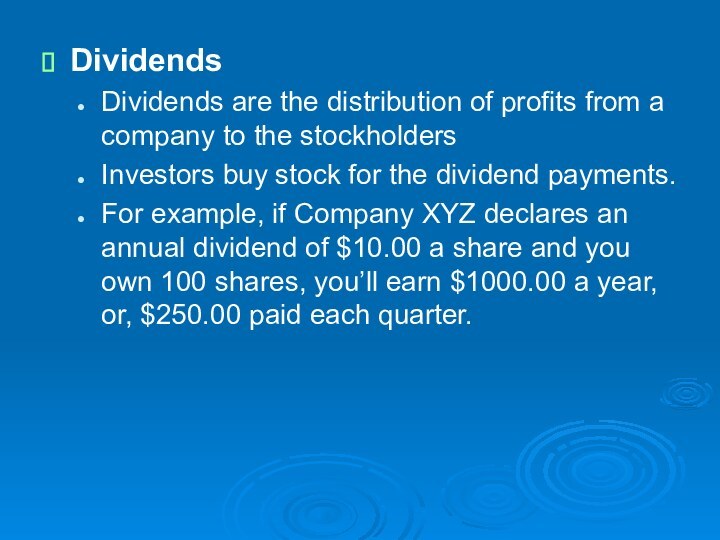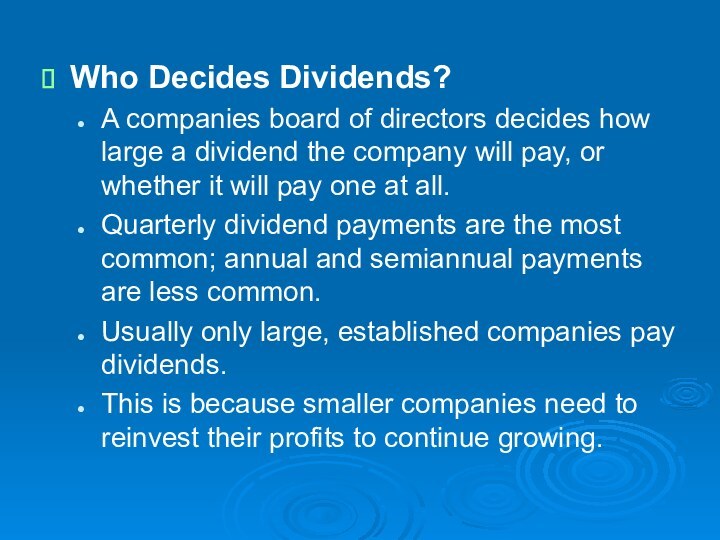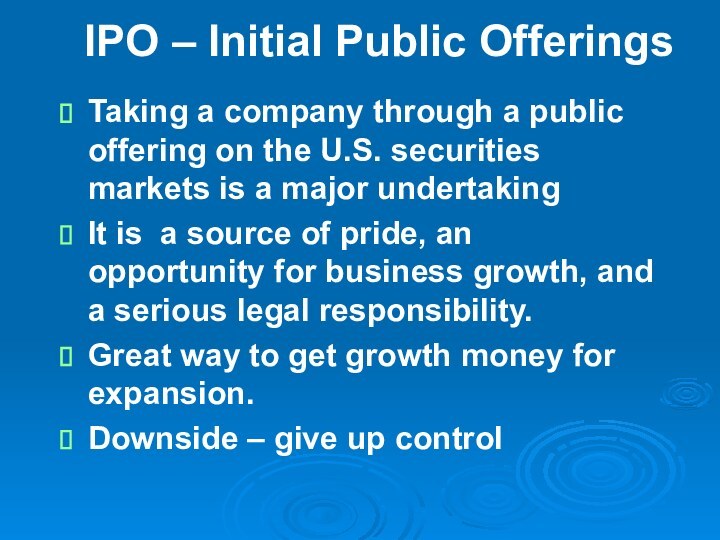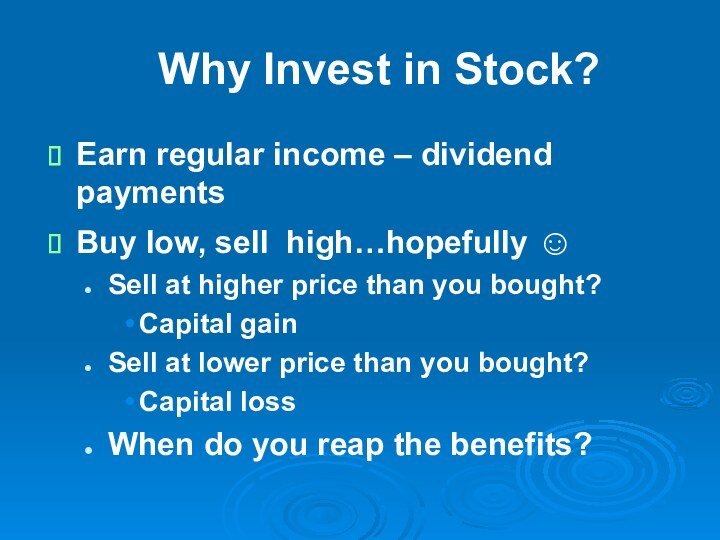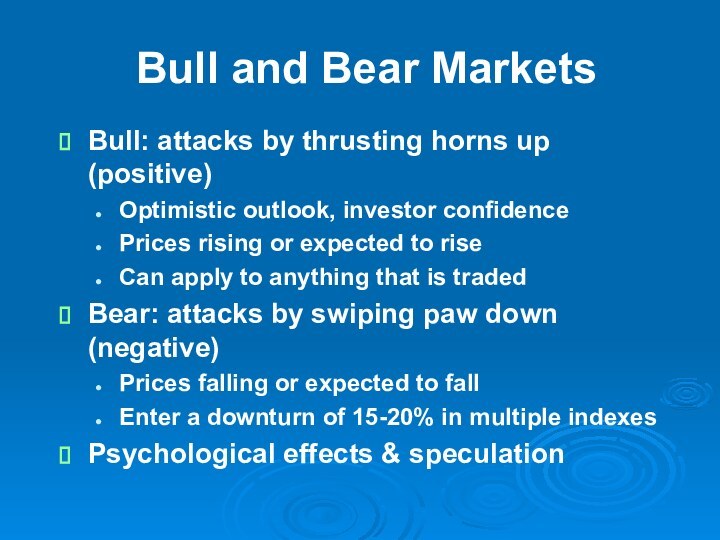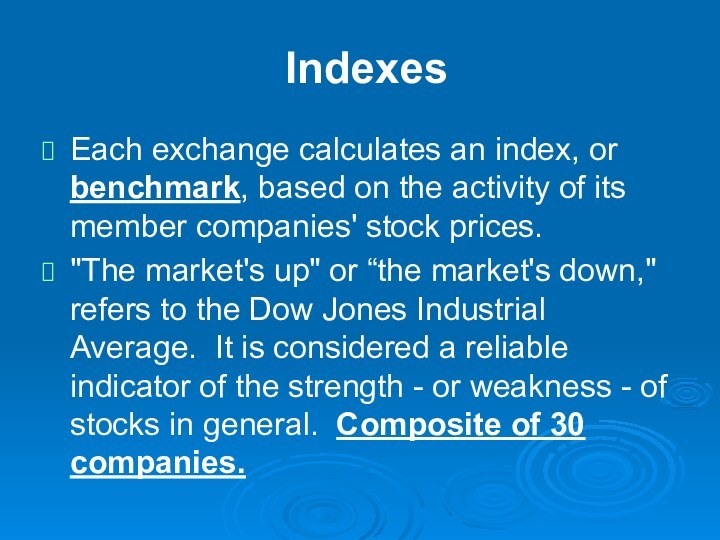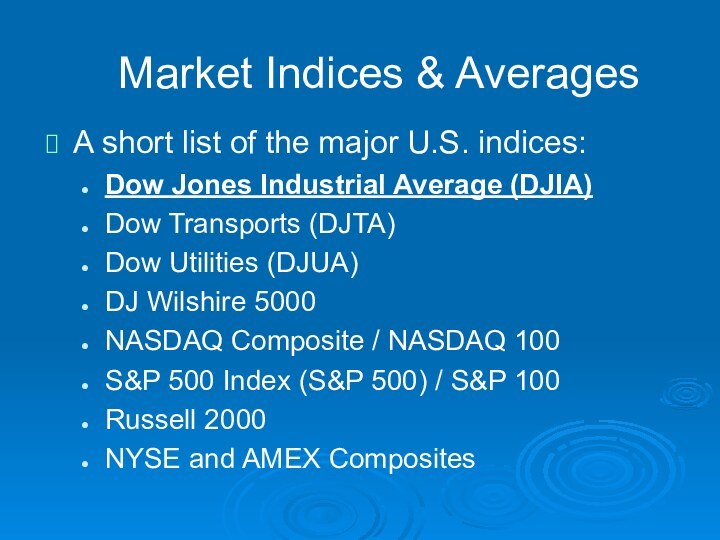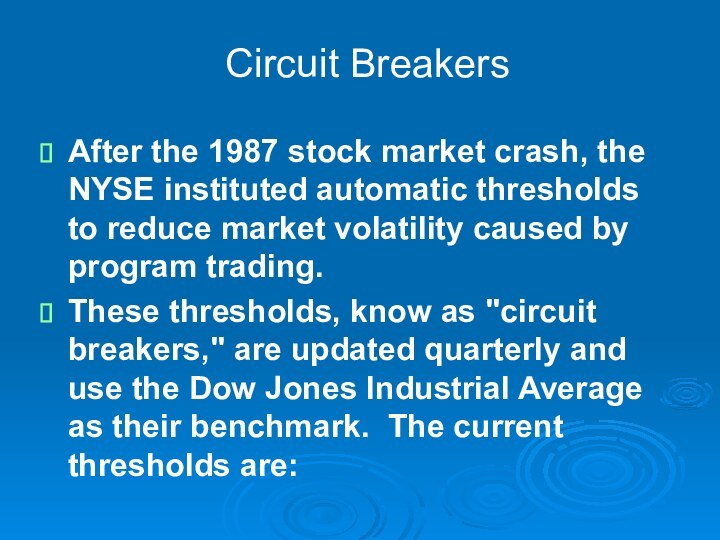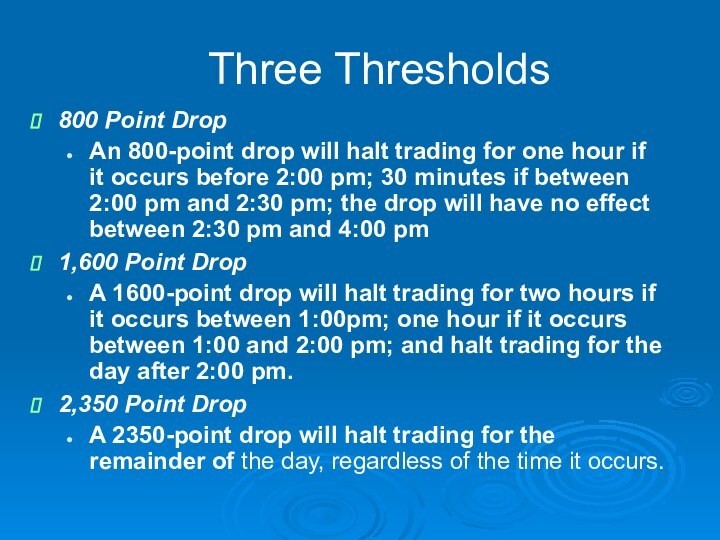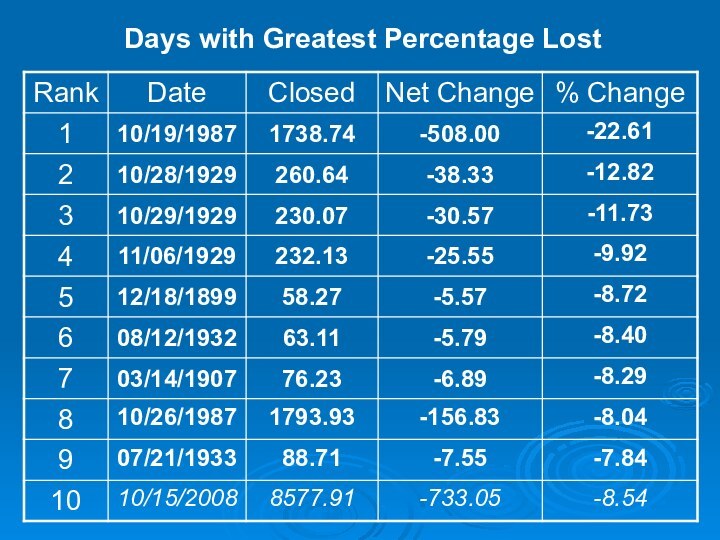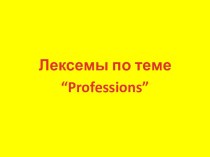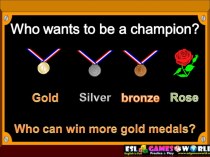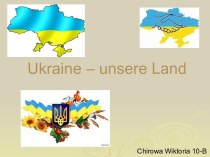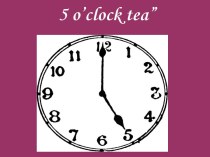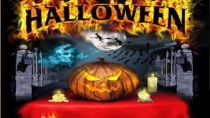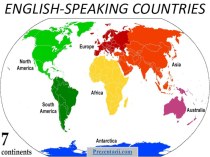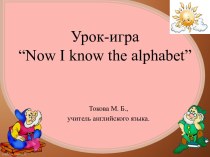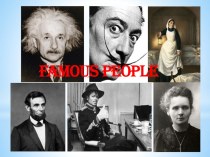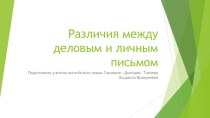Слайд 2
What To Do With Income?
Pay taxes
Spend it (consume
today)
Save it (delay consumption to future)
Invest it
Using money you
have saved to purchase a product that will create benefits in the future
Saving and investing involves trade-offs
Слайд 3
Saving and Investment
Saving
Not consuming all current income
Examples:
Savings Account, Certificate of Deposit
Business Investment
Production and purchase of
capital goods
Examples: machines, buildings and equipment that can be used to produce more goods and services in the future
Personal investment
Purchasing financial securities
Examples: stocks, bonds, real estate, mutual funds
Pay a higher rate of return in the long run than the interest paid on savings accounts.
Слайд 4
Return, Risk and Liquidity
Rate of Return -Type of
profit or loss you are getting on your investment
(Interest on savings)
Liquidity – ease of turning assets into money
Return and Risk (direct relationship)
Greater risk, higher returns (NASDAQ stocks)
Less risk, lower returns (CD)
Return and Liquidity (inverse relationship)
Greater liquidity, lower return (CD)
Less liquidity, greater return (Bonds)
Слайд 5
How Liquid are the Following?
$20 Traveler’s Check
30 Day
Treasury Bill
Share of Microsoft Stock
$5,000 Savings Account
Apartment Complex
$1 (Dollar)
Bill
Gold bullion
IBM 20-year Bond
Share in money-market mutual fund
Credit card with $5,000 line of credit
Eurodollar savings account in a Swiss Bank
Your House
Oil painting by Monet
Categorize as “very liquid,” “somewhat liquid” or “illiquid”
Слайд 6
$20 Traveler’s Check
30 Day Treasury Bill
Share of Microsoft
Stock
$5,000 Savings Account
Apartment Complex
$1 (Dollar) Bill
Gold bullion
IBM 20-year Bond
Share
in money-market mutual fund
Credit card with $5,000 line of credit
Eurodollar savings account in a Swiss Bank
Your House
Oil painting by Monet
Categorize as “very liquid,” “somewhat liquid” or “illiquid”
Слайд 7
Major Exchanges
NYSE - New York Stock Exchange –
“The Big Board”
Founded in 1792, the oldest and most
prestigious stock exchange in the U.S. – 3,000 mostly large-cap companies
NASDAQ - National Association of Securities Dealers Automated Quotation System - computerized national trading system that lists more than 5300 small-cap & technology companies
AMEX - The American Stock Exchange founded in 1842 as the New York Curb Exchange – 700 companies
Слайд 8
Blue Chips
Largest most consistently profitable companies that usually
pay dividends
Coca-Cola
General Electric
McDonald’s
Exxon-Mobile
Wal-Mart
Gillette
Слайд 9
Types of Stocks
Common Stock
The most basic form
of ownership that a corporation issues.
It designates that
you own a fraction of the company.
The value of a common stock is directly influenced by the successes and failures of the issuing company.
It may or may not pay a dividend, which is the portion of the company's profits paid out to its shareholders.
Слайд 10
Preferred Stock
They receive their dividends before common stock
owners
If the company goes out of business, preferred stockholders
are paid back the money they invested before the common stockholders
For these reasons, preferred stock is generally less risky than common stock
The main drawback of preferred stock is that it cannot benefit as much from company profits because it only pays a fixed dividend
Слайд 11
Capital Gains and Dividends
Capital Gains
A profit made when
selling stock at a higher price than they paid
for it. Most people buy stock to make money from capital gains.
For example, if you buy 100 shares of Company XYZ at $100.00 a share (a total $10,000 investment) and sold it for $125.00 a share ($12,500), you’ve realized a capital gain of $25.00 a share, or $2,500.00.
Слайд 12
Dividends
Dividends are the distribution of profits from a
company to the stockholders
Investors buy stock for the dividend
payments.
For example, if Company XYZ declares an annual dividend of $10.00 a share and you own 100 shares, you’ll earn $1000.00 a year, or, $250.00 paid each quarter.
Слайд 13
Who Decides Dividends?
A companies board of directors decides
how large a dividend the company will pay, or
whether it will pay one at all.
Quarterly dividend payments are the most common; annual and semiannual payments are less common.
Usually only large, established companies pay dividends.
This is because smaller companies need to reinvest their profits to continue growing.
Слайд 14
IPO – Initial Public Offerings
Taking a company through
a public offering on the U.S. securities markets is
a major undertaking
It is a source of pride, an opportunity for business growth, and a serious legal responsibility.
Great way to get growth money for expansion.
Downside – give up control
Слайд 15
Why Invest in Stock?
Earn regular income – dividend
payments
Buy low, sell high…hopefully ☺
Sell at higher price than
you bought?
Capital gain
Sell at lower price than you bought?
Capital loss
When do you reap the benefits?
Слайд 16
Market Cycles
Ups and Downs
Throughout its history, the
stock market has tended to move in cycles of
activity.
The stock market is greatly affected by economics, social, and political factors.
While it's impossible to predict the market's future activity, one thing is certain: The stock market will continue to experience ups and downs.
Слайд 17
Bull and Bear Markets
Bull: attacks by thrusting horns
up (positive)
Optimistic outlook, investor confidence
Prices rising or expected to
rise
Can apply to anything that is traded
Bear: attacks by swiping paw down (negative)
Prices falling or expected to fall
Enter a downturn of 15-20% in multiple indexes
Psychological effects & speculation
Слайд 18
Indexes
Each exchange calculates an index, or benchmark, based
on the activity of its member companies' stock prices.
"The market's up" or “the market's down," refers to the Dow Jones Industrial Average. It is considered a reliable indicator of the strength - or weakness - of stocks in general. Composite of 30 companies.
Слайд 19
Market Indices & Averages
A short list of the
major U.S. indices:
Dow Jones Industrial Average (DJIA)
Dow Transports
(DJTA)
Dow Utilities (DJUA)
DJ Wilshire 5000
NASDAQ Composite / NASDAQ 100
S&P 500 Index (S&P 500) / S&P 100
Russell 2000
NYSE and AMEX Composites
Слайд 20
Circuit Breakers
After the 1987 stock market crash, the
NYSE instituted automatic thresholds to reduce market volatility caused
by program trading.
These thresholds, know as "circuit breakers," are updated quarterly and use the Dow Jones Industrial Average as their benchmark. The current thresholds are:
Слайд 21
Three Thresholds
800 Point Drop
An 800-point drop will halt
trading for one hour if it occurs before 2:00
pm; 30 minutes if between 2:00 pm and 2:30 pm; the drop will have no effect between 2:30 pm and 4:00 pm
1,600 Point Drop
A 1600-point drop will halt trading for two hours if it occurs between 1:00pm; one hour if it occurs between 1:00 and 2:00 pm; and halt trading for the day after 2:00 pm.
2,350 Point Drop
A 2350-point drop will halt trading for the remainder of the day, regardless of the time it occurs.
Слайд 22
Days with Greatest Percentage Lost
